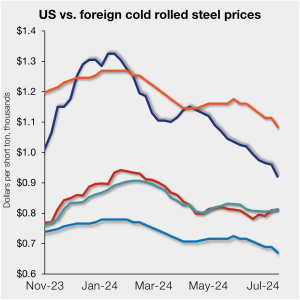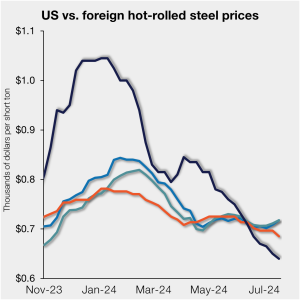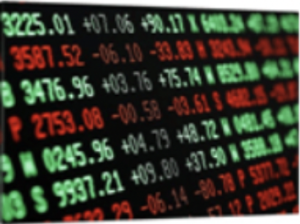Steel market chatter this week
On Monday and Tuesday of this week, SMU polled steel buyers on an array of topics, ranging from market prices, demand, and inventories to imports and evolving market events.
On Monday and Tuesday of this week, SMU polled steel buyers on an array of topics, ranging from market prices, demand, and inventories to imports and evolving market events.
Cleveland-Cliffs Chairman, President and CEO Lourenco Goncalves had some insightful things to say today about the steel market and about a conference we suspect might be Steel Summit.

SMU’s sheet price ranges slid again this week. But the declines were more pronounced on tandem products whereas prices for hot-rolled coil held roughly steady.
Cleveland-Cliffs expects its acquisition of Canada’s Stelco to close later this year, which will help the the Cleveland-based steelmaker as a bottom to steel tags nears.
SMU’s Key Market Indicators include data on the economy, raw materials, manufacturing, construction, and steel sheet and long products. They offer a snapshot of current sentiment and the near-term expected trajectory of the economy. All told, nine key indicators point lower, 16 are neutral, and 13 point higher. One thing worth noting: The nine indicators pointing lower are all lagging indicators. Many of those pointing upward are leading indicators.
Nucor recording lower second quarter earnings on falling steel prices. And the Charlotte, N.C.-based predicted that profits would be lower still in the third quarter, primarily because of weaker results from its steel mills divisions.
Cleveland-Cliffs’ earnings tumbled in the second quarter as the company cited weak demand and pricing.
Nucor kept its consumer spot price (CSP) for hot-rolled (HR) coil unchanged at $650 per short ton (st) this week. HR prices for CSI, the company's sheet subsidiary in California, held steady at $720/st. Note that sheet prices on the West Coast are typically higher than those east of the Rocky Mountains.
They say a picture is worth a thousand words. Well, when you add in some commentary from respected peers in the steel industry to those pictures, that may shoot you up to five thousand words, at least. In that spirit, we’ve added some snapshots from our market survey this week, along with some comments from market participants.

The price gap between US cold-rolled (CR) coil and imported CR has fallen to a 10-month low as domestic tags continue to drift lower. Domestic CR coil prices averaged $920 per short ton (st) in our check of the market on Tuesday, July 16, down $40/st from the week before. CR tags are now down […]

The United Kingdom and other countries are using the “green” label to subsidize bailouts of obsolete, inefficient, and excess capacity that should exit the market. US steelmakers have invested billions of dollars in technologies that curb greenhouse gas output. These investments have been market-based and led by EAF producers such as Nucor, Steel Dynamics, and CMC.

SMU’s Steel Buyers’ Sentiment Indices both saw improvement this week. Current sentiment ticked higher but remains near the four-year low seen earlier this month. Future Sentiment continues to indicate that buyers are optimistic for future business conditions.
The latest SMU market survey results are now available on our website to all premium members. After logging in at steelmarketupdate.com, visit the pricing and analysis tab and look under the “survey results” section for “latest survey results.” Historical survey results are also available under that selection. If you need help accessing the survey results, or if your […]
US light-vehicle (LV) sales fell to an unadjusted 1.32 million units in June, down 3.4% vs. year-ago levels, the US Bureau of Economic Analysis (BEA) reported. The year-on-year (y/y) dip in domestic LV sales came in with a 4% month-on-month (m/m) decline.
In this Premium analysis we cover North American oil and natural gas prices, drilling rig activity, and crude oil stock levels. Trends in energy prices and rig counts are an advanced indicator of demand for oil country tubular goods (OCTG), line pipe, and other steel products.
Operating income from Steel Dynamics Inc.’s (SDI) recycling operations clocked in higher in the second quarter than in the first on increasing volumes and despite lower realized pricing. Recycling operations brought in $32.1 million, an increase over $22.6 million in Q1, but lower than the $40.3 million last year, the Fort Wayne, Ind.-based company said […]
A roundup of aluminum news from CRU.
I thought we’d have more clarity this week on Section 232, Mexico, and a potential carve-out for steel melted and poured in Brazil. As of right now, the only official comment I have is from the Office of the United States Trade Representative (USTR).

Sheet steel buyers continue to report that mills are willing to talk price on new orders, according to our most recent survey data collected this week.

US hot-rolled (HR) coil prices this week drifted further below offshore hot band prices on a landed basis. The premium is now near a two-year low. SMU’s check of the market on Tuesday, July 16, put domestic HR coil tags at $640 per short ton (st) on average, down $10/st from last week. Stateside hot […]

The CME steel futures complex saw a slight decrease in activity from levels seen at the end of June. This has coincided with a notable decline in flat prices for the nearby futures contract, now August HRC, which is lower by $81 per short ton (st) since last writing on June 13. It settled at $672/st on July 17.
Growth in the US economy continues to be constrained. The Federal Reserve’s Beige Book report for July shows more areas reporting flat or declining economic activity than in its previous report at the end of May.
Steel Dynamics Inc.’s (SDI’s) earnings slid in the second quarter, but the company's top executive believes steel tags are set to rise.

The spread between hot-rolled coil (HRC) and prime scrap prices narrowed for the third consecutive month, hitting a level not seen since 2020, according to SMU’s most recent pricing data.
There are just 40 days left until the 2024 SMU Steel Summit gets underway on Aug. 26 at the Georgia International Convention Center (GICC) in Atlanta. And I’m pleased to announce that it's official now: More than 1,000 people have registered to at attend! Another big development: The desktop version of the networking app for the event has officially launched!
Cleveland-Cliffs has been pursuing M&A opportunities for some time now and thinks it has found a solid partner with aligned interests in Stelco. The companies announced on Monday that Cliffs would acquire the integrated Canadian steelmaker. That same day, Cliffs held a conference call with analysts to discuss the acquisition. Lourenco Goncalves, Cliffs’ chairman, president, […]
SMU’s hot-rolled coil price fell to $640 per short ton (st) on average on Tuesday. That’s down $10/st from last week and marks the lowest point for HR prices since December 2022, according to our pricing archives. SMU’s HR price is now $5/ton below 2023’s low of $645/st, which occurred against the backdrop of a United Auto Workers (UAW) union strike.
Flat Rolled = 60.9 Shipping Days of Supply Plate = 59 Shipping Days of Supply Flat Rolled US service center flat-rolled steel supply remained high at the end of June at 60.9 shipping days of supply, according to adjusted SMU data. This translates to 3.05 months of supply in June. At the end of May, […]
Scrap prices came in mostly sideways in July, with prime scrap prices edging down while shredded and HMS tags ticked up slightly, scrap sources told SMU. They believe a bottom has been reached in the market.
Nucor dropped its consumer spot price (CSP) for hot-rolled coil to $650 per short ton, down $20/st from last week. The Charlotte, N.C.-based steelmaker also said base prices for HR from CSI, its subsidiary in California, would be $720/st. That’s a $30/st decrease from $750/st a week ago.